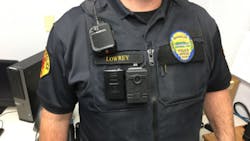A technology hailed by some and condemned by others, body cameras have garnered the attention of many law enforcement managers. In fact, a recent survey conducted by our website, Officer.com, shows that 37 percent of agencies in the U.S. report having body cameras on at least some of their officers. Body camera adoption is predicted to continue to grow in the coming years as many law enforcement agencies view the technology as a pro for officers.
Does this technology, however, have the potential to dictate tactics? The question was originally asked by Bill DeWeese, a detective with the Hocking County Sheriff’s Office in Logan, Ohio, and a presenter at this year’s ILEETA conference in St. Louis, Mo. DeWeese, while acknowledging the usefulness of body cameras, sees the potential in being governed by the technology.
DeWeese points to the fact that chest mounted body cameras can be covered up in a cover and conceal scenario where concealment hides the officer’s presence and cover stops a bullet. Rather than protecting him or herself, an officer could be worried whether or not their body camera was picking up footage. “I’m afraid some people would end up changing their stance or tactics to accommodate the body camera, rather than the other way around,” he says. “Problems can arise if an officer is worried about capturing the video more so than they are about the tactics they were taught in training.”
The problem for DeWeese comes from personal experience. He wears his body camera 50 percent of the time, most oftentimes on his chest. What he found early on is that when holding his firearm in a proper stance, his arms covered up most of the video footage captured on his body camera. “I ended up with useless video,” he says. DeWeese poses a valid concern. Body camera video footage is invaluable in some cases, acting as the impartial third point of view. Is it possible that some officers are changing the way they operate in order to make sure they’re capturing an encounter on video? To dig deeper, I posed this question to several other law enforcement agencies and body camera manufacturers.
The best placement
The town of Waterloo, Iowa sits in the north central part of the state with a population of around 70,000. In 2009 the city had four officer-involved shootings, which led the Waterloo Police Department to begin outfitting all of its officers with body cameras manufactured by L3. Greg Erie, training officer for the police department, likes the ease of body cameras. “It’s not complicated, you just turn the camera on and off,” he says.
The cameras have worked well for the agency so far, he explains, and they haven’t changed tactics for their officers. Rather, they’ve improved relations between police and civilians. “People behave better when they know they are on camera,” he jokes. “So far we haven’t had a problem with our body cameras being used against officers. We pull footage when a citizen complains but it generally goes in favor of our officers. We don’t ever put safety after anything else and that’s one thing we’ve trained our officers.”
When the Waterloo Police Department began wearing body cameras, one of the challenges was determining where to put them. “Worn on a polo patrol shirt, we found the body cameras tend to point downward because of the weight and the way it clips on,” Erie says. “It’s problematic finding a place to clip the camera depending on what you’re wearing, especially if an officer has a coat on. If it’s worn on outer body armor it clips on much tighter so there is less sagging.”
Finding a proper placement for body cameras is one way to avoid compromising tactics. DeWeese would like to see more body camera options, including mounted glasses. “The advantages this viewpoint has is that it gives relatively the same perspective the officer has and it moves as the officer turns his or her head,” he says.
The downside, says DeWeese, is that officers care about their look and wearing glasses with a camera may not be a desirable concept. “As officers, we want to expose ourselves as little as possible and the officer using cover properly would cover his or her body cam if it is located in the middle of the body, but if it’s mounted on glasses, you can still get video without changing tactics.” He believes there must be placement options for officers, and that’s where manufacturers are designing technology to fit those challenges.
Technology evolves to fit the profession
Manufacturers have been responding to these challenges by continuously developing the technology to form to the officers, rather than the other way around.
WatchGuard Video, a manufacturer of body worn cameras and in-car video systems, focuses on research and development to ensure that its technology continues to evolve to fit officers’ needs. “Our job is to support the officer and the camera should, as closely as possible, document the officer’s point of view,” says Jaime Carlin, marketing communications manager of WatchGuard Video. As such, the camera needs to stay true to life as much as possible. “We don’t want to develop a camera that is so much better than the human eye that it has those reviewing the video after an incident questioning why the officer didn’t see or react to something it wasn’t humanly possible to react to ,” she continues. “It is a constant conversation in the development of product .” In terms of placement WatchGuard offers several options and will introduce a two-piece body camera this summer that allows the user to wear memory and battery on his or her duty belt while providing options as to where the mic and lens can be worn, such as the chest, shoulder, hat or otherwise. This feature was designed to work with an officer’s training not dictate it, explains Carlin.
Dave Kingston, general manager of VIEVU, notes that body cameras were created with the desire to convey an objective view, keeping officer safety top of mind. Body cameras aren’t dictating tactics, he says. Rather, they oftentimes aid officers in intense conflict. “In one instance, a person barricaded themselves in a room and the officer lowered his body camera and saw inside the room and they decided to delay entry based on that view,” he says. VIEVU’s focus has been on creating body cameras with design and ease of use in mind. “The last thing a user wants is to be fumbling with technology in the line of duty,” he says. The company offers a single-touch slider to easily turn the device on and off, a feature appreciated by its users.
When it comes to investing in body cameras, Carlin notes that the technology will continue to evolve and manufacturers will continue to design cameras and systems to fit the needs of law enforcement. “Understanding the needs and demands of the profession is essential and then asking ‘Where does the tech need to follow?’ should drive the responsible development of the product,” she says.
It’s also up to the officer and the department to make sure they are properly training with the body cameras, so when used in the field, there is no question of how the technology works.
The importance of training
Though a department of 225 officers in uniformed patrol, the Lincoln (Neb.) Police Department has just five officers wearing body cameras. In Oct. 2016 the Nebraska Commission on Law Enforcement and Criminal Justice approved a statewide policy on body-worn cameras, which creates minimum standards for their use, including training. “We are required to have initial and annual training, which covers things like where to wear the body camera, how to use it, how to tag data and upload content,” says Jeff Bliemeister, chief of police for the Lincoln Police Department.
Training with the body camera before taking it into the field has huge benefits for the officers, such as knowing what it’s recording and how it moves with the user in different situations. Erie, of the Waterloo Police Department, recommends that officers use a body camera to their advantage and train with it often. “Find the camera’s limitations,” he says. “Test the length of recording and know its weakness. Find out what it can do. And know that it will most likely fall off when you wrestle someone,” he says.
VIEVU’s Kingston agrees that training is integral. “Practice with your body camera and go back and review your footage,” he says. “See what is covered when you use the correct tactics, that way you can adjust the camera around your tactics to get the best footage, not the other way around.”
Going forward
Body cameras are here to stay in law enforcement, says Erie. “Even if you’re in a small agency, you need to have different vendors come in and present you with body camera options,” he says. “Look at the storage options and costs. Try the cameras out and most importantly, make sure your camera can’t see what the human eye can’t see.”
So far, Lincoln PD’s Chief Bliemeister doesn’t think body cameras have dictated tactics for his officers who wear them. He is hopeful, however, that the technology will change how officers and citizens interact—in a more positive manner. “I’m a big advocate of body cameras, as I believe they modify behavior for those who know they’re being recorded, and they also record events as they happen,” he notes.
While there is the possibility that body cameras could change tactics for some who aren’t careful, it’s unlikely to be a burden for most as manufacturers continue to evolve technology to fit the profession and officers continue to train with their body cameras and place safety above all else.

Adrienne Zimmer | Editor
Adrienne Zimmer was the Editor of Law Enforcement Technology magazine, a monthly business-to-business publication that covers technology trends and best practices for public safety managers from 2017 to 2019. LET is part of Officer Media Group, which also publishes Law Enforcement Product News and Officer.com. Adrienne has been in publishing since 2013.



